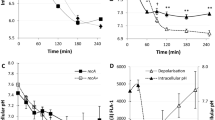Summary
Caffeine enhanced the degradation of DNA to acid soluble fragments in cultures of Escherichia coli exposed to Phleomycin (≦2 μg/ml). Enhancement was particularly striking with stationary phase cultures, which normally exhibit negligible DNA breakdown when treated with ≦2 μg/ml of Phleomycin. There is little DNA breakdown or death in UVR strains treated with phleomycin (≦2 μg/ml) during exponential growth but when caffeine was present as well as Phleomycin, the kinetics of DNA breakdown and the amounts of DNA degraded were identical in all cultures tested including those of UVR, EXR, B/r type and B strains and equal to the maximum rate observed (with an EXR strain) in the absence of caffeine (ca. 1.7 % per min). High concentrations of Phleomycin (≧10 μg/ml) had the same effect as the caffeine+Phleomycin (≦2 μg/ml) combination and produced a uniform pattern of DNA breakdown in all strains tested. Caffeine did not seem to increase permeability of the bacterial coat. Given to the cells before exposure to Phleomycin it was ineffective in enhancing DNA breakdown. On the other hand, exposure of the bacteria to Phleomycin for a period of ≧40 min at 37° followed by caffeine was as effective as adding the two drugs together.
Caffeine increased the efficiency of Phleomycin as an antibiotic for both growing and stationary phase cultures of e. coli B. It is suggested that caffeine aids the cooperative denaturation of DNA initiated by the attachment of Phleomycin molecules to thymine bases. This would allow single strand-specific endonucleases to attack the DNA and initiate DNA breakdown and cell death.
Similar content being viewed by others
References
Fries, N., Kihlman, B.: Fungal mutations obtained with methyl xanthines. Nature (Lond.) 162, 573 (1948).
Glass, E. A., Novick, A.: Induction of mutation in chloramphenicol inhibited bacteria. J. Bact. 77, 10 (1959).
Grigg, G. W.: The association of caffeine resistance and ultraviolet sensitivity in Escherichia coli. A simple method of selecting radiation sensitive and radiation resistant mutants. Mutation Res. 4, 553–557 (1967).
—: Caffeine-death in Escherichia coli. Molec. Gen. Genetics 102, 316–335 (1968).
—: Induction of DNA breakdown and death in Escherichia coli by Phleomycin. Its association with dark-repair processes. Molec. Gen. Genetics 104, 1–11 (1969).
—: The effects of caffeine, ultraviolet and X-irradiation on DNA breakdown in Escherichia coli B and some of its dark-repair mutants. Molec. Gen. Genetics 106, 228–238 (1970).
—, Stuckey, J.: The reversible suppression of stationary phase mutation in escherichia coli by caffeine. Genetics 53, 823 (1966).
Holliday, R.: Induced mitotic crossing over in Ustilago maydis. Genet. Res. 2, 231–248 (1961).
Johnson, H. G., Bach, M. K.: Apparent suppression of mutation rates in bacteria by spermine. Nature (Lond.) 208, 408 (1965).
Kihlman, B., Levan, A.: The cytological effects of caffeine. Hereditas (Lund) 35, 109–111 (1949).
Leive, L.: A non-specific increase in permeability in Escherichia coli produced by EDTA. Proc. nat. Acad. Sci. (Wash.) 53, 745–750 (1965).
Pietsch, P., Garrett, H.: Primary site of reaction in the in vitro complex of phleomycin in DNA. Nature (Lond.) 219, 488–489 (1968).
Rauth, A. M., Domon, M., Barton, B.: The interaction of caffeine with U.V. irradiated DNA. Radiat. Res. Soc. Abst., in press (1969).
Setlow, R. B.: Molecular changes responsible for ultraviolet inactivation of the biological activity of DNA. In: Mammalian cytogenetics and related problems in radiobiology. New York: Pergamon Press 1964.
—, Carrier, W.: The excision of pyrimidine dimers in vivo and in vitro. In: Replication and recombination of genetic material. Aust. Acad. Sci., Canberra, p. 134–141 (1968).
Setlow, R. B., Carrier, W., Williams, R.: Strand breaks during excision of pyrimidine dimers in vivo. Abstracts Biophys. Soc. TG-Z, p. 83 (1967).
Strauss, B.: DNA repair mechanisms and their relation to mutation and recombination. In: Current topics in microbiology and immunology. Berlin-Heidelberg-New York: Springer 1968.
Ts'o, P. O., Lu, P.: Interaction of nucleic acids. 1. Physical binding of thymine, adenine, steroids and aromatic hydrocarbons to nucleic acids. Proc. nat. Acad. Sci. (Wash.) 51, 17–24 (1964).
Witkin, E. M.: The role of DNA repair and recombination in mutagenesis. Proc. XII Intern. Congr. Genetics 3, 225–245 (1969a).
Author information
Authors and Affiliations
Additional information
Communicated by R. Pritchard
This paper is dedicated to charlotte Auerbach on the occasion of her official retirement.
Rights and permissions
About this article
Cite this article
Grigg, G.W. Amplification of phleomycin induced death and DNA breakdown by caffeine in escherichia coli . Molec. Gen. Genetics 107, 162–172 (1970). https://doi.org/10.1007/BF00333632
Received:
Issue Date:
DOI: https://doi.org/10.1007/BF00333632




